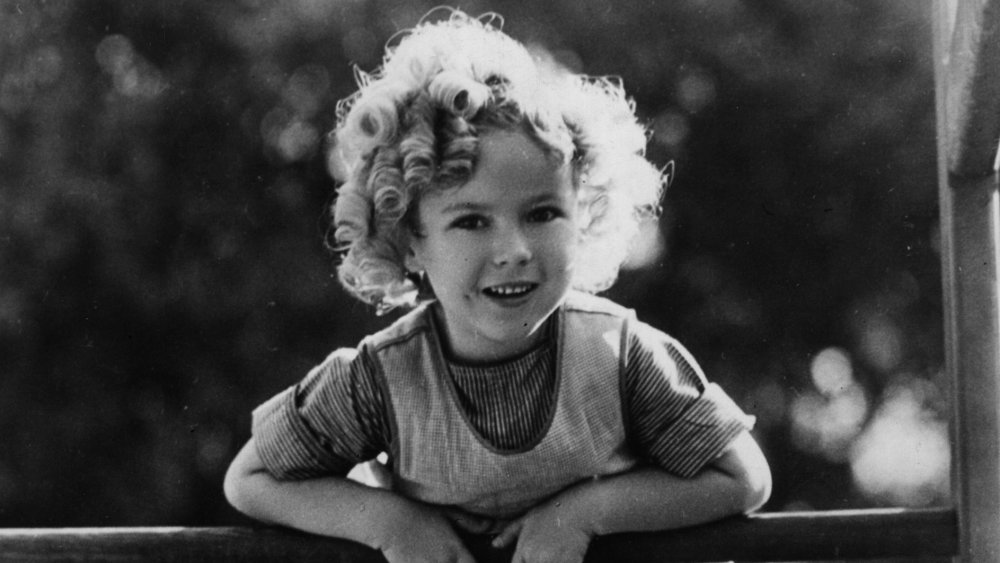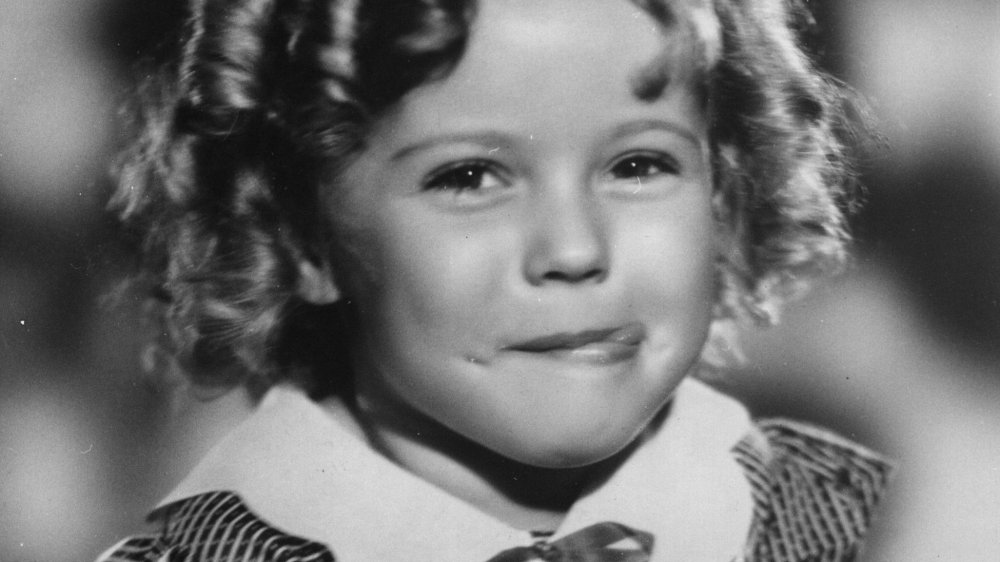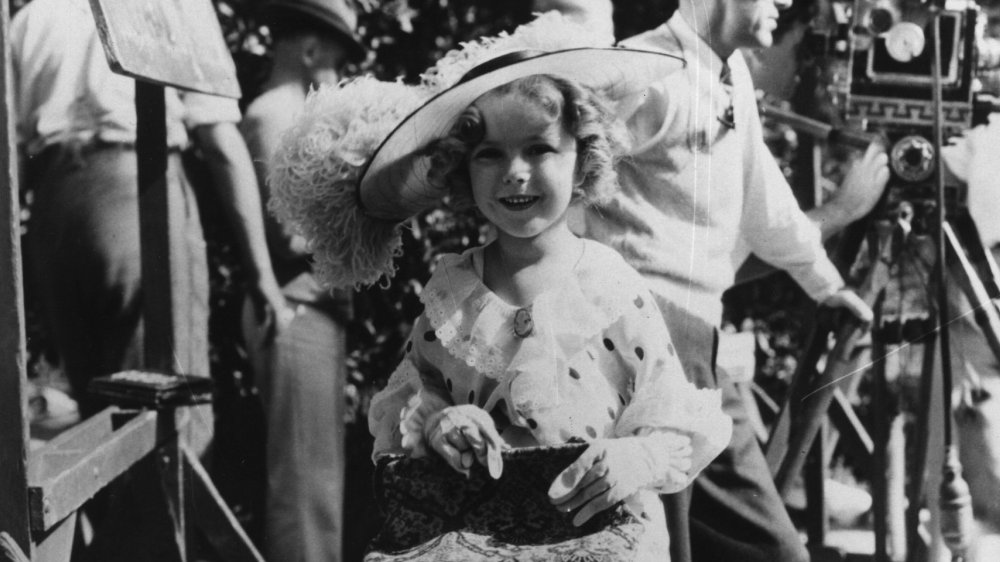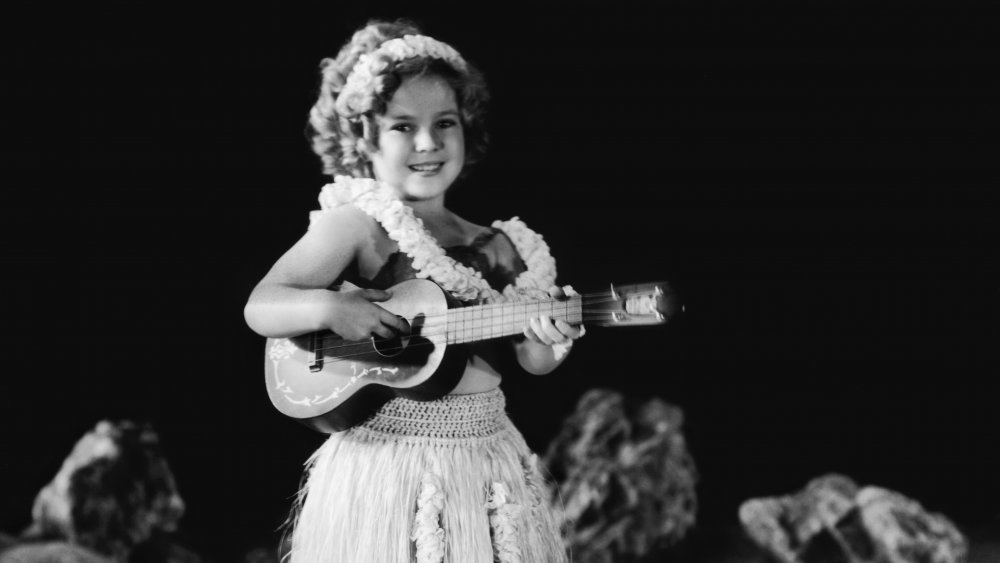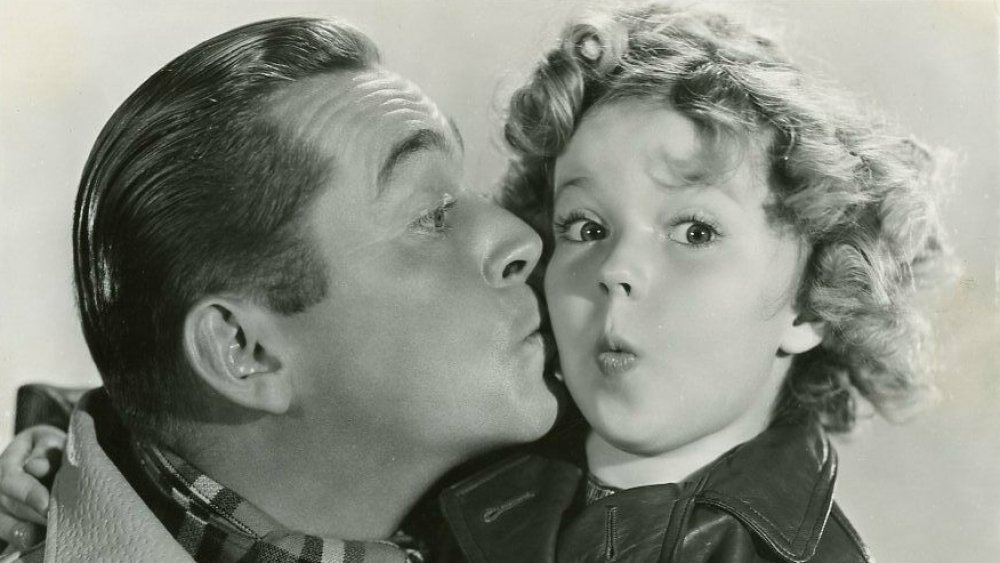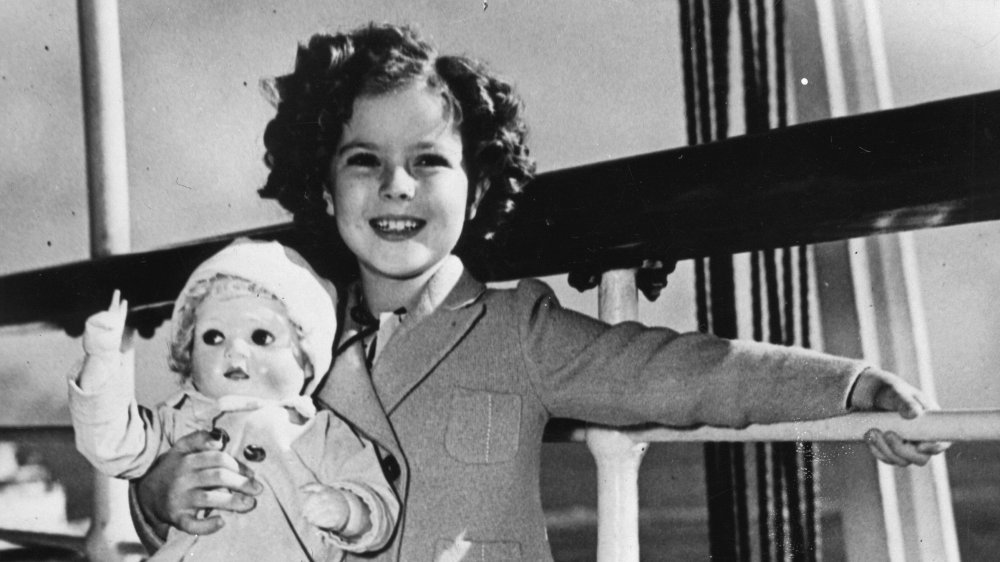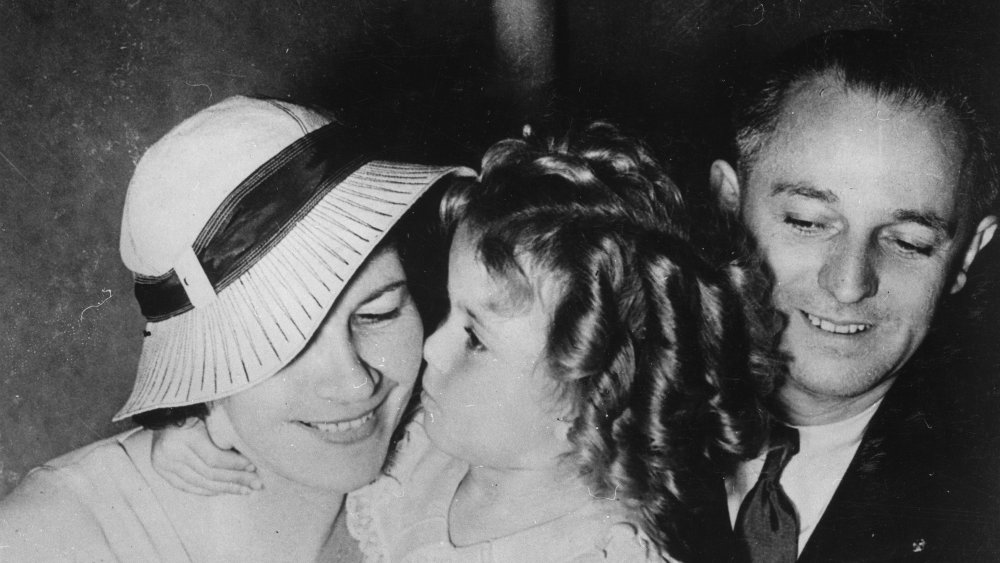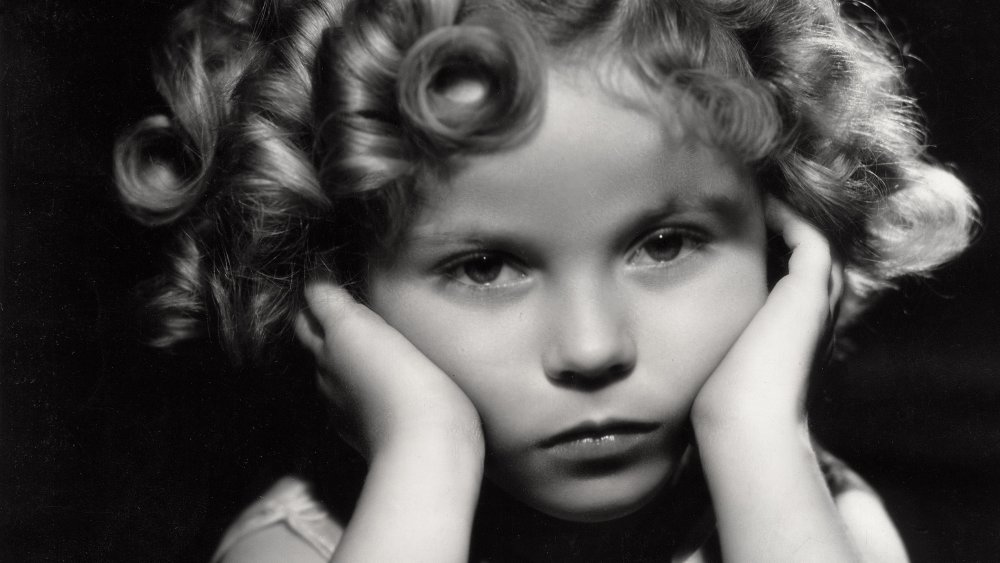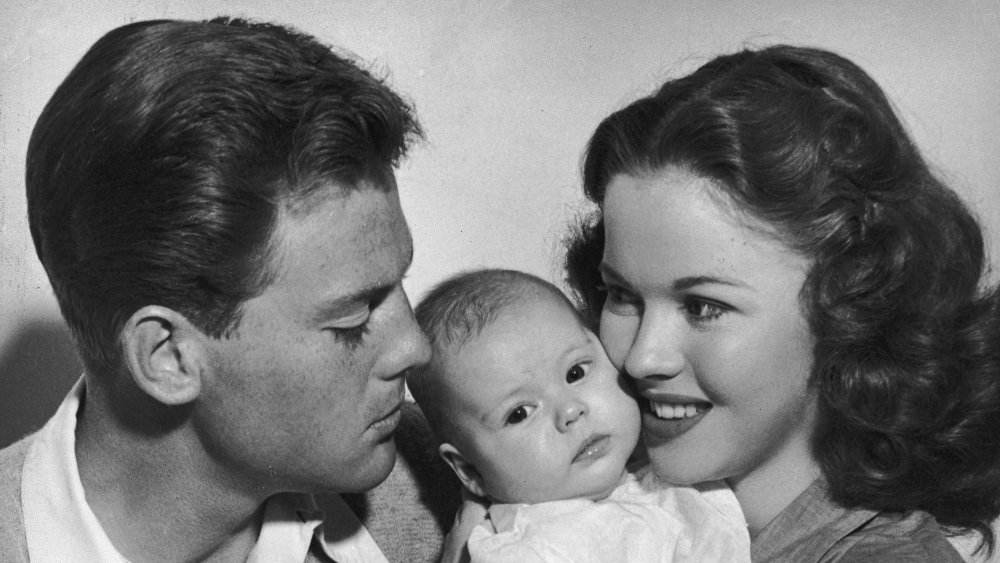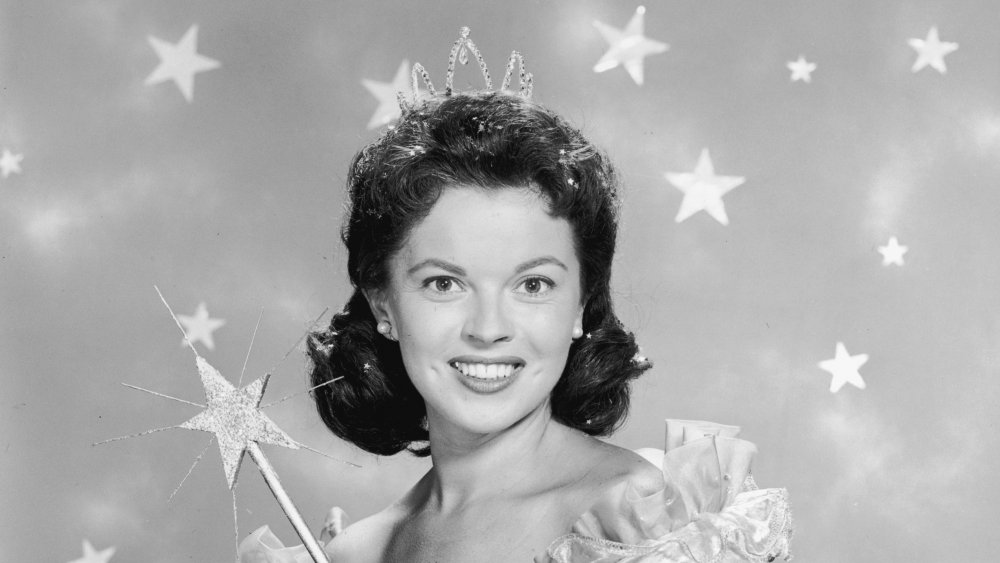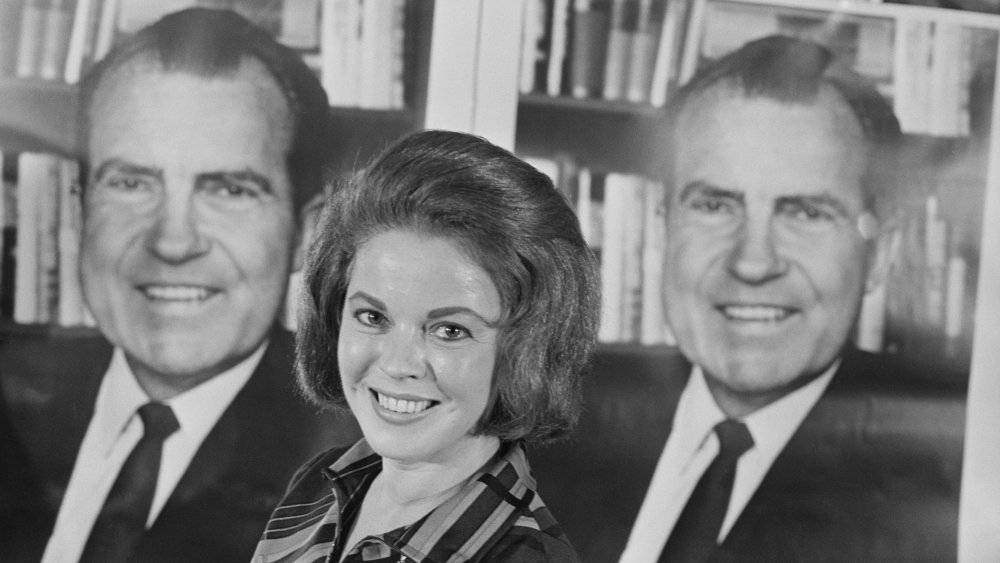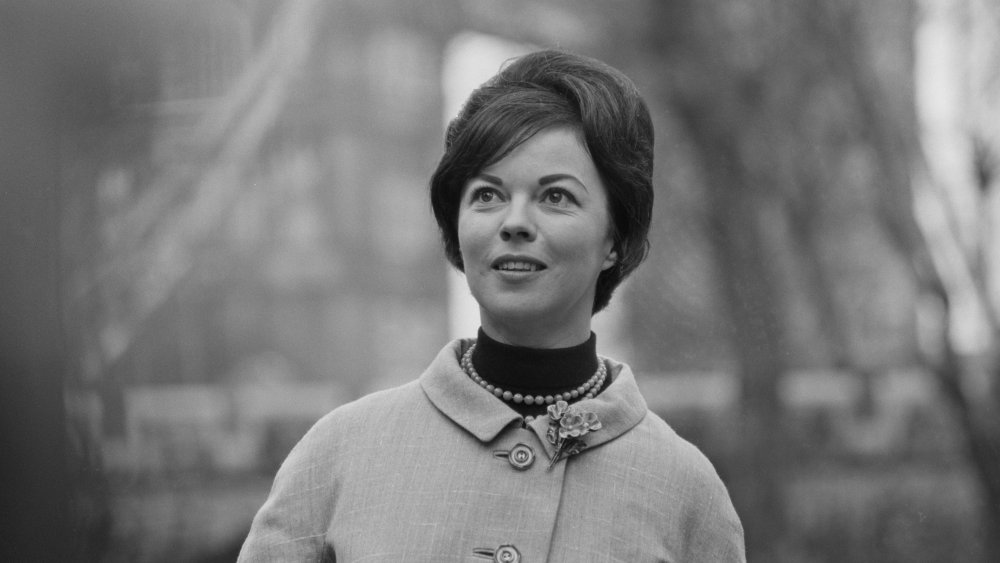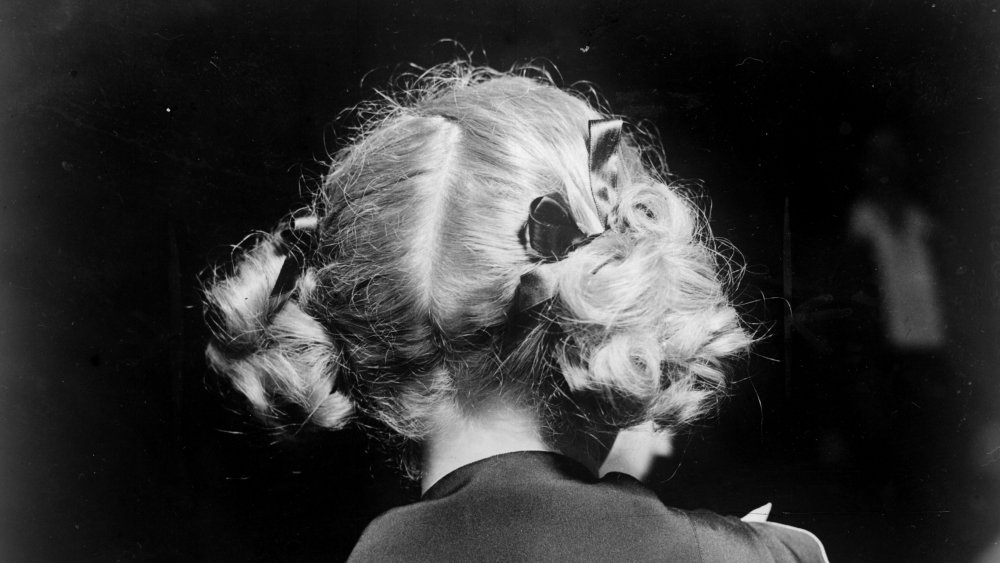The Tragic Real-Life Story Of Shirley Temple
Few child stars have ever achieved the level of celebrity that Shirley Temple had. She was a worldwide phenomenon who inspired dresses, dolls, and even a drink. Nicknamed "America's little darling" and "Little Miss Miracle," she became a symbol of optimism at a time when the United States was reeling from the Great Depression. And when the public lost interest in her as an entertainment performer, Temple tailored her performances into politics and devoted herself to social service and international diplomacy for almost 30 years.
Despite the glitz and glamour of show business, Shirley Temple's life wasn't as carefree as many assumed. Fans would ask if her hair was real and accused her of being a fake child. Temple also frequently had to resist the advances of studio executives and older men in the entertainment industry. And even though Temple made more than $3 million during her acting career, she ended losing most of her total earnings due to her parents' poor financial decisions, per TV Guide.
Ultimately, Temple defied all expectations and went on to become one of the most successful child stars of all time, on and off the screen. But beneath the dimpled smile was just a young girl who ended up putting up with much more than she ever should've. This is the tragic real-life story of Shirley Temple.
Shirley Temple's career began at age four
Born on April 23rd, 1928, Shirley Jane Temple was just three years old when her mother, Gertrude, perceptive of Temple's burgeoning talent, signed her up for dance lessons. But the decision wasn't entirely selfless. Gertrude herself had wanted to become a dancer and was intent on her daughter succeeding where she had failed. According to Biography, it was at the dance school that Temple was discovered by producers from Educational Films Corporation.
Despite the name, the shorts made by the film distribution company were oriented more towards the comedic than instructional. In 1932, Temple was cast in a series of shorts called "Baby Burlesks," where children played the satirized roles of adults. Temple's first speaking role occurs in the second "Baby Burlesks" short titled "War Babies," where Temple plays an exotic dancer as toddlers in diapers ogle her. Her first on-screen kiss came occurred when Temple was just five years old.
According to The Atlantic, the set of "Baby Burlesks" wasn't the kindest place for children. If anyone misbehaved, they were sent to sit on a block of ice in a black sound booth. While Temple later wrote in her autobiography that she didn't think that the black box did any permanent damage to her psyche, "its lesson of life, however, was profound and unforgettable. Time is money. Wasted time means wasted money means trouble," as quoted in the Washington Post.
The early films of Shirley Temple
Shirley Temple's roles in "Baby Burlesks" caught the eye of Fox Film Corporation, which would later merge with Twentieth Century Pictures in 1935 to create 20th Century-Fox. According to Newsweek, after songwriter Jay Gorney saw an episode of Frolics of Youth, another multi-part series produced by Educational Pictures that Temple appeared in. Gorney was struck when he saw Temple entertaining fans in a movie theater lobby as he left the screening. He was so charmed by her that he promptly arranged for Temple to audition for the film Stand Up and Cheer! in December 1933. She quickly got the part and was signed to a "two-week guaranteed, $150-per-week contract." By the end of the month, her contract had been given a year extension as well as an option for seven years.
According to Encyclopedia Britannica, Stand Up and Cheer!, which came out in 1934, was Temple's first major motion picture. And by the end of the year, she'd been given a starring role in Little Miss Marker as well. She appeared in a number of other films in 1934, but the musical Bright Eyes is considered to be the film that made her such a celebrity. Bright Eyes was written specifically for Temple and in it, she sang what became her most popular song, "On the Good Ship Lollipop."
Temple was one of Hollywood's greatest box office attractions
Between 1935 and 1938, Shirley Temple was Hollywood's top box-office attraction, beating out stars such as Bing Crosby and Clark Gable, per Democrat & Chronicle. According to Newsweek, her film Curly Top, which came out in July 1935, made $1.1 million at the box office. According to the BBC, Temple is even credited with keeping 20th Century Fox from bankruptcy, especially due to the success of the film Bright Eyes.
In the midst of the Great Depression, President Franklin D. Roosevelt even credited her with raising people's spirits, referring to Temple as "Little Miss Miracle," CNN notes. Dickie Moore, another child star of the time, said that Temple could "make people believe, if only for 90 minutes, that there were no problems in the world."
Temple appeared in at least three movies a year between 1935 and 1938, sometimes upwards of eight, often playing an orphan whose optimism was reassuring to audiences during a time of economic turmoil and uncertainty. According to The Little Girl Who Fought the Great Depression by John F. Kasson, the light-hearted comedy of Temple's films was not meant to "change the world but to summon the emotional resources simply to persevere in it. In all her 1930s movies beginning with Stand Up and Cheer!, Shirley Temple helped them to do so."
A juvenile award for Temple
In 1935, Temple's role in Bright Eyes earned her an Academy Award. According to Good Housekeeping, Temple both received and presented an award at the 7th Annual Academy Awards, but the award she received was the very first of its kind.
According to Atlas Obscura, Temple was awarded the very first Juvenile Academy Award "in grateful recognition of her outstanding contribution to screen entertainment in 1934," per Oscar.org. The Juvenile Oscar was created so that child performers wouldn't have to compete against grown-ups and were awarded to those aged between six and 18. The Oscar could be awarded for a particular film, or for general work over the year, as was done with Temple.
The Juvenile Oscars themselves were roughly half the size of the adult Oscars. And according to The New Yorker, Temple criticized the shrunken Oscar in her autobiography, noting that, "Someone's cute idea to match my height with a shrunken Oscar badly misfired. If mine was really a commendable job well-done, why not a big Oscar like everyone else's?"
The last Juvenile Oscar was awarded in 1961 to Hayley Mills for Pollyanna. After 16-year-old Patty Duke won Best Supporting Actress in 1963, the Oscar committee decided that the Juvenile Oscar was no longer necessary. Coincidentally, the last Juvenile Oscar was presented by Temple, the first Juvenile Oscar winner.
Shirley Temple gets merchandised
Temple's popularity led to many products being created in her name and likeness. According to Fashion Historia, Temple-themed merchandise included raincoats, dresses, and accessories. There was also a Shirley Temple doll made by the Ideal Novelty and Toy Company. According to Collectors Weekly, the doll was officially announced in October 1934 and came outfitted in a polka-dotted dress similar to the once worn by Temple in Stand Up and Cheer!. In 1935, the Shirley Temple doll accounted for almost one-third of all doll sales, even though it cost three times as much as unlicensed dolls. Her iconic hairstyle was also imitated by many.
And while there are conflicting accounts of the drinks origin, the Shirley Temple drink is also named after the child star. But funnily enough, Temple herself wasn't a fan of the drink, saying that it was too sweet for her taste. Temple also turned down many offers to license her name for the mocktail, noting that she doesn't like the idea of cocktails, even non-alcoholic ones, for children.
By 1935, Temple was making $1,000 a week just from merchandising and by 1936, her royalties from licensing exceeded $200,000.
Shirley Temple's finances
Despite the fact that Shirley Temple was making a great deal of money, she didn't end up seeing much of it. After Temple had signed her studio contract in 1934, her father George became her manager. And although he fought repeatedly for pay increases, it was more for his benefit than his daughter's.
According to Newsweek, by the end of 1935, Temple's salary was $2,500 per week, and in 1936, it rose to $50,000 per movie. According to The Atlantic, in 1938, at $307,014, Temple was making more money in a year than anyone else in Hollywood other than Louis B. Mayer, one of the co-founders of MGM. But despite the money coming in from merchandising and movies, when Temple was 22, she discovered that even though she had earned over three million dollars, she reportedly had $44,000 in her account.
With the spending of her parents and her father's mismanagement of her wealth, Temple was left with a fraction of the fortune she had earned. But despite everything, Temple later wrote that "for reasons some of you may find inexplicable, I felt neither disappointment nor anger."
Struggling against rumors and producers
Shirley Temple was regularly treated poorly during her film career. During the 1932 film Runt Page, Temple got an ear infection and had to have her eardrum lanced at a hospital. And despite her mother's pleading, the producer insisted that Temple be at the studio in the morning or she would be replaced.
According to The Atlantic, Temple also had to frequently fend off advances from men. During her first visit to MGM, the producer Arthur Freed unzipped his fly in front of Temple. When she was 17, producer David O. Selznick also literally chased her around an office, "expecting his 'due' as her boss," per Newsner. In 1939, a woman also tried to assassinate Temple because she believed that Temple had stolen her daughter's soul.
Temple was also plagued by various rumors, such as that her hair wasn't real or that she wasn't really a child. Some even claimed that her teeth had been filed to appear more like baby teeth. Often, fans would pull on her hair to check if it were a wig or not, according to Refreshing Life. Temple herself wished that she had been able to wear a wig since her real hair warranted nightly rituals that included a weekly vinegar rinse that caused her eyes to burn. The rumor that she wasn't actually a child was so widespread that the Vatican sent Father Silvio Massante to investigate Temple's true age, per The Hollywood Reporter.
Temple takes a break from movies
Shirley Temple's popularity began to wane as she grew up and matured. According to The Atlantic, Temple had already "started to age out of commercial viability" at just 12 years old. After one of her movies, The Blue Bird, did poorly in the box-office in 1940, Fox dropped her contract, and although she then signed with MGM, she never made another hit like the ones from her childhood.
According to CNN, during this time Temple started going to school again in Los Angeles and began to focus on a non-celebrity life. As she continued her schooling, Temple continued to appear in various films throughout the 1940s such as That Hagen Girl and The Bachelor and the Bobby Soxer, but despite receiving critical praise, none were box office successes. Her final film, A Kiss for Corliss, came out in 1949, and it also received a lukewarm reception.
Temple had married fellow actor John Agar in 1945, hoping that he could help protect her from the muddled life of Hollywood, but instead Agar turned out to be a violent alcoholic who only added to Temple's troubles, per The Life and Times of Hollywood. They divorced a few years later, in 1949, but Temple's divorce added to her "adult" image. "'Little Miss Miracle' was growing up," as Biography put it.
Finding it more and more difficult to land major roles, Temple stepped away from the big screen.
Temple made a brief pivot to television
After taking a break from films to focus on motherhood, Temple returned to the entertainment industry in the 1950s, though this time on a smaller screen. From 1957 to 1959, Temple hosted a television show titled "Shirley Temple's Storybook," an anthology series that retold classic fairy tales. Temple's three children even appeared in the final episode of the first season, "Mother Goose."
According to Women's History, although the show didn't have a long run, Temple once more inspired a line of merchandise that included coloring books, dolls, and handbags. And although ABC TV dropped "Storybook" in 1960, the program was picked up by NBC TV and renamed "The Shirley Temple Show." Unfortunately, the show was considered less successful than its ABC version and was canceled by NBC in 1961. However, in the end, NBC broadcasted over 40 episodes.
But by the mid-1960s, Temple decided to put her entertainment career behind her and started focusing on politics.
Shirley Temple's diplomatic career
After Shirley Temple married Charles Alden Black and they moved to Washington D.C. for his career, Temple started working as a Republican fund-raiser, per Smithsonian Magazine. In 1967, Temple turned her full attention to politics and entered the congressional race in California. Although she ultimately lost, her political career was only just beginning.
Temple was a lifelong member of the Republican Party and campaigned for Richard Nixon in 1968. According to Biography, Temple served as a United States ambassador to the United Nations from 1969 to 1970 under President Nixon. President Gerald Ford also appointed Temple as the United States Ambassador to Ghana from 1974 to 1976.
Her political work continued when in 1976, Temple became the first woman to be United States chief of protocol at the State Department, serving until 1977 under President Ford. President Ford even joked that her loss in the congressional race was a blessing that allowed her to do diplomatic work, stating that she had "been so successful in the latter, it's probably better that [she] didn't win it before."
In 1988, Temple was given the first honorary title of "Foreign Service Officer" in recognition of her work as a diplomat. Temple also worked alongside her former co-star Ronald Reagan, with whom she had starred in 1947's That Hagen Girl, as a foreign affairs officer-expert while he was president.
Temple was also appointed by President George H.W. Bush as the ambassador to Czechoslovakia from 1989 to 1992, during which time she primarily lived in Prague.
Shirley Temple raised awareness for breast cancer
At the time when Shirley Temple was diagnosed with breast cancer in 1972, the disease was rarely talked about, especially in public. Celebrities at the time also frequently hid their illnesses from the public. But Temple sought to dispel the stigma and shame around breast cancer, so when she underwent a mastectomy, she spoke to reporters directly from her hospital bed, as the New York Times reported.
According to Groovy History, while she was recovering in the hospital, Temple explained to reporters how a cancerous lump had been discovered in her left breast and that the breast had to be removed as a result. Not only was it uncommon for a celebrity to be so candid about their illness and its treatment, the openness with which Temple discussed her breast cancer diagnosis was also aimed at providing information to women that doctors at the time weren't necessarily giving.
At the time, informed consent also wasn't common, and many women who thought they were just having a biopsy would wake up to find that they'd undergone a radical mastectomy, since doctors "assumed the entire burden of deciding how patients with breast cancer should be treated," according to Dr. George Crile in a 1972 medical document. But as Temple advocated for self-examinations, Temple became an outspoken advocate for women's agency in regards to their health.
Shirley Temple's later life and death
Shirley Temple was appreciated across political party lines, and in 1998, President Clinton awarded her the Kennedy Center Honors in recognition of her years of diplomatic service. After her work in politics, Temple went on to serve on the board of directors for a number of organizations, not limited to Bank of America, The Walt Disney Company, and the National Wildlife Federation.
In 2006, she was also awarded the Screen Actors Guild Lifetime Achievement Award. Even though Temple's film career lasted roughly 20 years, she made an unforgettable impression. Her husband, Charles Black, had died the year before, so their son accompanied her to the awards ceremony.
Temple didn't distinguish much between her entertainment career and her political career during her life, claiming once that, "Politicians are actors too, don't you think?" per CSMonitor. And for her, the years she spent in Hollywood were just as enjoyable as her years in social service.
On February 10th, 2014, Shirley Temple died from pneumonia and chronic obstructive pulmonary disease (COPD) at the age of 85. She was survived by her three children.
